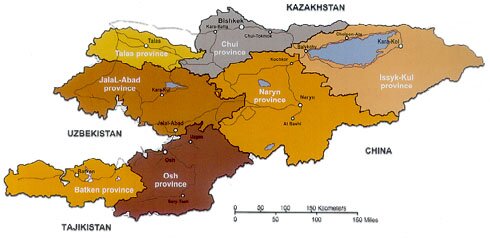Geographical Position and Administrative regions
The Kyrgyz Republic occupies the heart of the Central Asia, bordered on Kazakhstan, Uzbekistan, Tajikistan and China. Kyrgyzstan is dominated by Tien-Shan Mountains, the world's third highest mountain range. Mountains account for 93 percent of the republic's territory, 40 percent of which reach beyond 3,000 meters. Issyk-Kul, the world's fifth deepest lake, fills a large mountain basin in the east and is a source of great national pride. The climate in Kyrgyzstan is continental: cold winters, hot summers and low precipitation.

The country is divided into seven administrative provinces headed by governors: Chui, Issyk-Kul, Osh, Talas, Jalal-Abad, Naryn and Batken.
Ethnicity and Religion
Of the almost five million Kyrgyz people, 65.7 percent are ethnic Kyrgyz, 13.9 percent are Uzbek and 11,7 percent Russian. Since independence, one quarter of ethnic Russians previously resident in Kyrgyzstan left for Russia, with some returning now. There are smaller numbers of Germans, Koreans, Tartars, Chechens and Ukrainians, all of whom were settled in Kyrgyzstan during the Stalin dislocations of the 1930s and 1940s. Kazakhs, Dungans and Uighurs are also presented all over the country.
Islam and Orthodox Christianity are the main religions. Kyrgyz, a Turkic language, is the official language. Russian is widely used in public and private life by all ethnic groups, and has an official status.
Economy
Of the twelve non-Baltic USSR republics, Kyrgyzstan was the first to declare independence from the Soviet Union in 1991. Since it gained independence The Kyrgyz Republic has made impressive progress in building a state, a democracy and a market-oriented economy based on private property and the rule of law.
Kyrgyzstan remains one of the least developed countries in the region. The current GDP is only at 66 percent of the pre-independence level, 40 percent of which is still generated in the agricultural sector by 60 percent of the active workforce. GDP per capita is USD 308 (PPP 2521 USD), which makes Kyrgyzstan one of the 62 low-income countries in the world. The fragility of growth (5.3 percent in 2001, and a decline by 0.5 percent in 2002) is reflected by strong dependence on a single product, gold, exported by the Kyrgyz-Canadian gold mining company Kumtor accounting for almost 40 percent of all exports. Despite recent reports on a 5-percent poverty reduction, 2.5 million people (48 percent of the population) live below the poverty line (USD 12.7 a month) in remote rural and mountainous areas (more than 90 percent of the territory).
Although the debt burden has recently been eased through an agreement with the Paris Club for the next three years only, it remains one of the key development challenges and stands at a crushing 107 percent of GDP. With the decline of production and budget revenues the spending during the past eight years on social protection and education was reduced by half to 1.8 and 3.5 percent respectively. The infant mortality rate (estimated by WHO at 66.6 per 1000) and the under-five mortality (75.8) are also on the rise.
In 2002, the UN System was supporting Kyrgyzstan's major national development planning activities. The World Bank, UNDP and IMF were instrumental in assisting the country to adopt its three-year National Poverty Reduction Strategy (NPRS). The UNCT facilitated the enactment of the National Gender Equality Action Plan and supported preparation and conducting of the Bishkek Global Mountain Summit, held within the UNGA-proclaimed International Year of Mountains. The UN Joint Programme on HIV/AIDS prevention has become a bulwark of the National AIDS Prevention Strategy. The UNCT and Interagency MDG Task Force spearheaded the national launching of the MDG campaign and the preparation of the first MDG Report, due in February 2003. Early involvement of the Government and NGOs in the MDG reporting and monitoring resulted in the national ownership and linkages between MDGs and NPRS.
|

